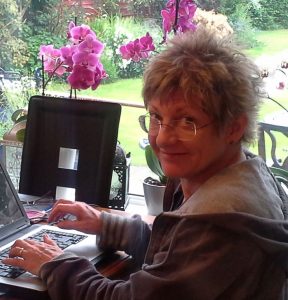Rain or shine, I walk the dogs. Our joint outings make great locations. Every time I pass an overgrown ditch, I swear I can hear the music of Murder She Wrote.
My favourite spot is a genuine Gothic ruin by the river just outside Kenilworth where I live. Built in 1751 and abandoned in the 1950s (long story), its empty windows look out over a picturesque bend of the Avon.
Guy’s Cliffe House is a hidden Warwickshire gem and not even open to the public. To add to its mystique, it’s haunted, so they say. It even sports a hermit’s cave and a medieval love story with a tragic ending.

There’s a walk on the other side of the river. One starts at the Saxon Mill pub, the site of the original mill, next to a weir filled with oozing, treacly water. The place exudes an ancient atmosphere.
One day in early summer a few years ago, I was trundling down the path with my two rescue dogs, Lottie and Chester. Ahead lay the manor with its glowering façades, overgrown rhododendrons and noisy jackdaws nesting in the chimney pots. I wondered if anyone had ever written a story about the place. It seemed more than likely.
But no. The nearest I found was a TV Sherlock Holmes drama that Granada TV had filmed starring the inimitable Jeremy Brett in 1992 and managed to set fire to the ruin, causing even more damage. Eerily, the story was called The Last Vampyre. You can still see the scorch marks. (Interestingly, Jeremy Brett hailed from Berkswell, a small village nearby.)
I mused on what story I would set there. As I mulled it over, I walked past a bank of Himalayan Balsam, which I discovered later is known by the wonderful Latin name of Impatiens glandulifera.
My grandparents were keen wild life enthusiasts, and I recalled them explaining how it had been introduced as a foreign wonder, but how it had adapted rather too readily and was now invasive. I looked it up afterwards. These plants were all promoted at the time as having the virtues of ‘Herculean proportions’ and ‘splendid invasiveness’, as if this were a good thing. In fact, the seeds popped out of the open windows of a greenhouse, where the first one was kept to make sure it was safe. Ironic, that.
I realised I’d learned of all sorts of botanical stories, often featuring intrepid Scottish plant collectors, sent into hostile lands to discover new species to grace the gardens of the (mainly English) gentry.
And that was it. I had the plot of my book. A retired plant collector. Romantic twist … a young heroine, disgraced after a failed elopement. A spooky mansion with a dark past and a sinister purpose.
Once I got home, I ordered a handful of botanical history books. My kind of research! When I started to read about so-called orchidomania, or a passion for orchids that swept across Victorian Britain, I knew I had the theme.
I know writers who burn to tell a particular tale. In my case, the setting came before the story.
So, I read up about orchids. It is hard not to boggle at the extraordinary lengths collectors went to find new species, tackling pirates, famine, storms, civil wars, hungry insects and even hungrier cannibals. Fantastic sums were offered, especially to rediscover ‘lost’ orchids, ones that had been found, and which had vanished, either as the result of over-zealous collectors or natural catastrophes. Every orchid, it seemed, had a story. The ‘lost’ orchids were the most alluring.

One particularly colourful story tells of the Paphiopedilum curtisii, a striking slipper orchid, first found in 1882 by Charles Curtis. Curtis would only say the plants were from Sumatra. Once the initial shipment had been sold, the price shot up.
Five years later, the rival firm of Sander and Sons sent a new collector, the Swede Claes Ericsson, to Sumatra, charged with following Curtis’ trail. Another five years went by as Ericsson trawled the inhospitable jungles, shipping back plenty of new orchids – dodging the cannibals in the area who had developed a taste for Europeans. After several deaths, the authorities forbade further travel, but Ericsson got permission to take an armed party into the mountains. Then, it seems he, or one of the party, became ill, and they rested at a small hospital near the capital Padang. As he lay in bed, he spotted a scrawled message on the wall and a drawing of a slipper orchid, alongside the initials CC. Convinced that Curtis had indeed passed that way, the party set off once again and sure enough, one of the hired locals returned with the elusive bloom. Two days later, they had collected several thousand plants, and successfully shipped them all back to Sander in England – thanks to the invention by Nathaniel Ward of the glass-sided Wardian case.
Inspired by Guy’s Cliffe, I made up my own fantastic tale (which is no crazier than some of the anecdotes) and decided to stick to Kenilworth. Weary of London-centric drama, I felt it was to create a historical mystery set in a lesser-known part of the country.
Of course, I became addicted to orchids myself. I am now the proud owner of over a dozen, which are lined up on my windowsills in all their splendour. They constantly amaze me: one has been flowering non-stop since 2011. The flowers of another resemble pansies and smell like roses. I came up with Orchidmania, a blog for all those equally obsessed.
When The Lost Orchid is published by Bluewood Publishing on 4 April, I shall treat myself to a new plant. But what colour to choose?
I’m fond of the heroine Flora McPhairson and her uncle, a veteran plant collector-turned-hybridiser, so I’m planning a sequel all about pteridomania – the Victorian passion for ferns.
So, pteridophyta, clubmosses, spikemosses, quillworts, horsetails, scouring-rushes, whisk ferns, adders-tongues and moonworts here I come. No doubt I’ll get addicted all over again and fill my garden with greenery galore.

Author bio:
With a background in languages, editing and journalism, I now have six books: Ice Trekker, Half Life and Dark Interlude (all with MuseItUp Publishing); and Tomorrow’s Anecdote (Crooked Cat). Next month sees the release of my late father’s original Cold War thriller, Not With a Whimper, which I edited. I now live in Kenilworth, with my husband Rob, a professor of inorganic chemistry, keen pilot and WW2 aviation enthusiast with whom I co-wrote Half Life. Our daughter Lauren is doing History of Art at the University of Edinburgh. I love murder mysteries in any form, along with Victoriana, art galleries, botany, bird-watching and blockbusters.
Links:
The Lost Orchid – available from 4 April @ BluewoodPublishing.com
Also available at Smashwords, and Amazon.
Book website – http://lostorchid.blogspot.co.uk/
Orchidmania – http://orchidmania-pk.blogspot.co.uk/
Author blog – http://pamkelt.blogspot.co.uk/
Author website – http://pamelakelt.weebly.com/news.html







